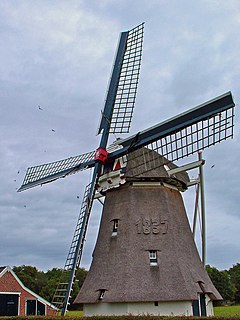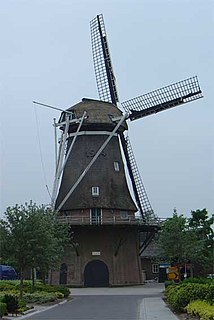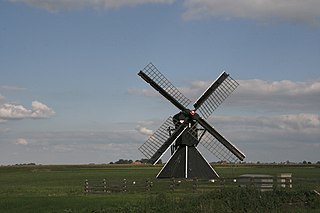
De Weert is a smock mill in Meppel, Drenthe, the Netherlands. It was built in 1998 and is listed as a Rijksmonument, number 526385.

The Grutte Mûne is a smock mill in Broeksterwâld, Friesland, Netherlands which has been restored to working order. The mill is listed as a Rijksmonument, number 11679.

Aylvapoldermolen is a smock mill in Burgwerd, Friesland, Netherlands which has been restored to working order. The mill is listed as a Rijksmonument, number 15626.

De Zwaluw is a smock mill in Oudemolen, Drenthe, the Netherlands. It was built in 1837 and is listed as a Rijksmonument, number 38148.

De Hoop is a smock mill in Sleen, Drenthe, the Netherlands, which has been restored to working order. The mill was built in 1914 and is listed as a Rijksmonument, number 33787.

De Wachter is a smock mill in Zuidlaren, Drenthe, which has been restored to working order. The mill was built in 1851 and is listed as a Rijksmonument, number 41064.

De Heimerter Mole is a hollow post mill in Burgwerd, Friesland, Netherlands which has been restored to working order. The mill is listed as a Rijksmonument, number 39348.

Windlust is a smock mill in Burum, Friesland, Netherlands which was built in 2014, replacing an earlier mill that had burnt down on 8 April 2012.

De Hoop is a smock mill in Dokkum, Friesland, Netherlands which was built in 1849 and has been restored to working order. The mill is listed as a Rijksmonument, number 13186.

Zeldenrust is a smock mill in Dokkum, Friesland, Netherlands which was built in 1862 and has been restored to working order. The mill is listed as a Rijksmonument, number 13097. The name translates as, "Seldom at rest."

De Poelen or De Puollen is a smock mill in Dronryp, Friesland, Netherlands, which was built in 1850. The mill is listed as a Rijksmonument, number 28612.

De Gans is a smock mill in Ezumazijl, Friesland, Netherlands which has been restored to working order. The mill is listed as a Rijksmonument, number 31571.

De Hantumermolen is a smock mill in Hantum, Friesland, Netherlands which was built in 1880. The mill has been restored to working order. It is listed as a Rijksmonument, number 38619.

Welgelegen or Tjepkema's Molen is a smock mill in Heerenveen, Friesland, Netherlands, which was built in 1849 and has been restored to working order. The mill is listed as a Rijksmonument, No. 21171.

Penninga's Molen or De Jonge Wester is a smock mill in Joure, Friesland, Netherlands which was built in 1900 and is working for trade. It is also used as a training mill. The mill is listed as a Rijksmonument, number 20842.

Meerswal is a smock mill in Lollum, Friesland, Netherlands which was built in 1903. The mill has been restored to working order and held is reserve for use in times of emergency. It is listed as a Rijksmonument, number 39364.

De Korenaar is a smock mill in Sexbierum, Friesland, Netherlands which was built in 1868 and is in working order. The mill is listed as a Rijksmonument.

Koartwâld, or Feanstermoune is a smock mill in Surhuisterveen, Friesland, Netherlands, which was built in 1864 and has been restored to working order. The mill is listed as a Rijksmonument.

De Vrouwbuurstermolen is a smock mill in Vrouwenparochie, Friesland, Netherlands which was built in 1862 and is in working order. The mill is listed as a Rijksmonument.

De Onderneming is a smock mill in Witmarsum, Friesland, Netherlands which was built in 1850 and is in working order. It is used as a training mill. The mill is listed as a Rijksmonument.





















